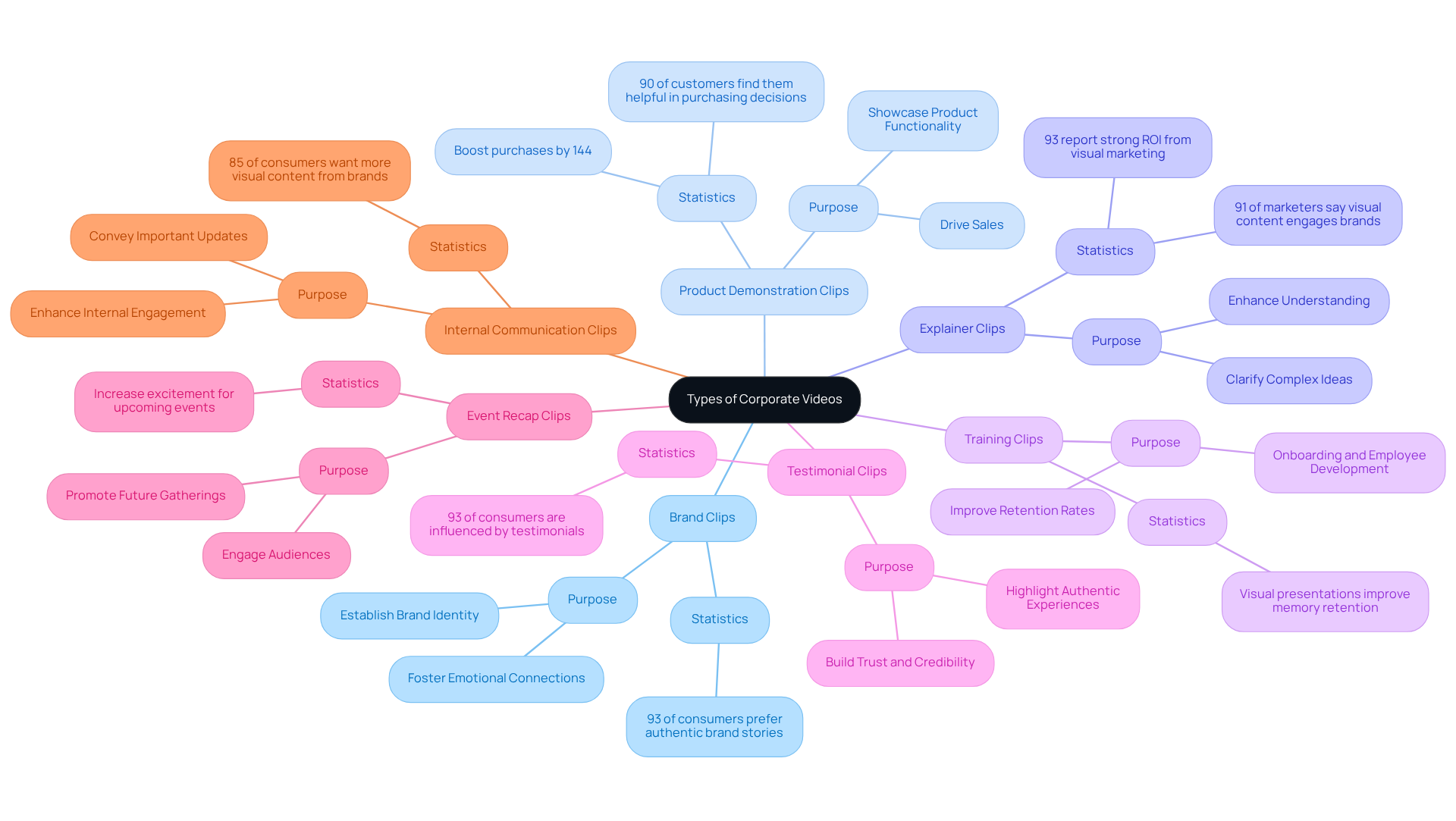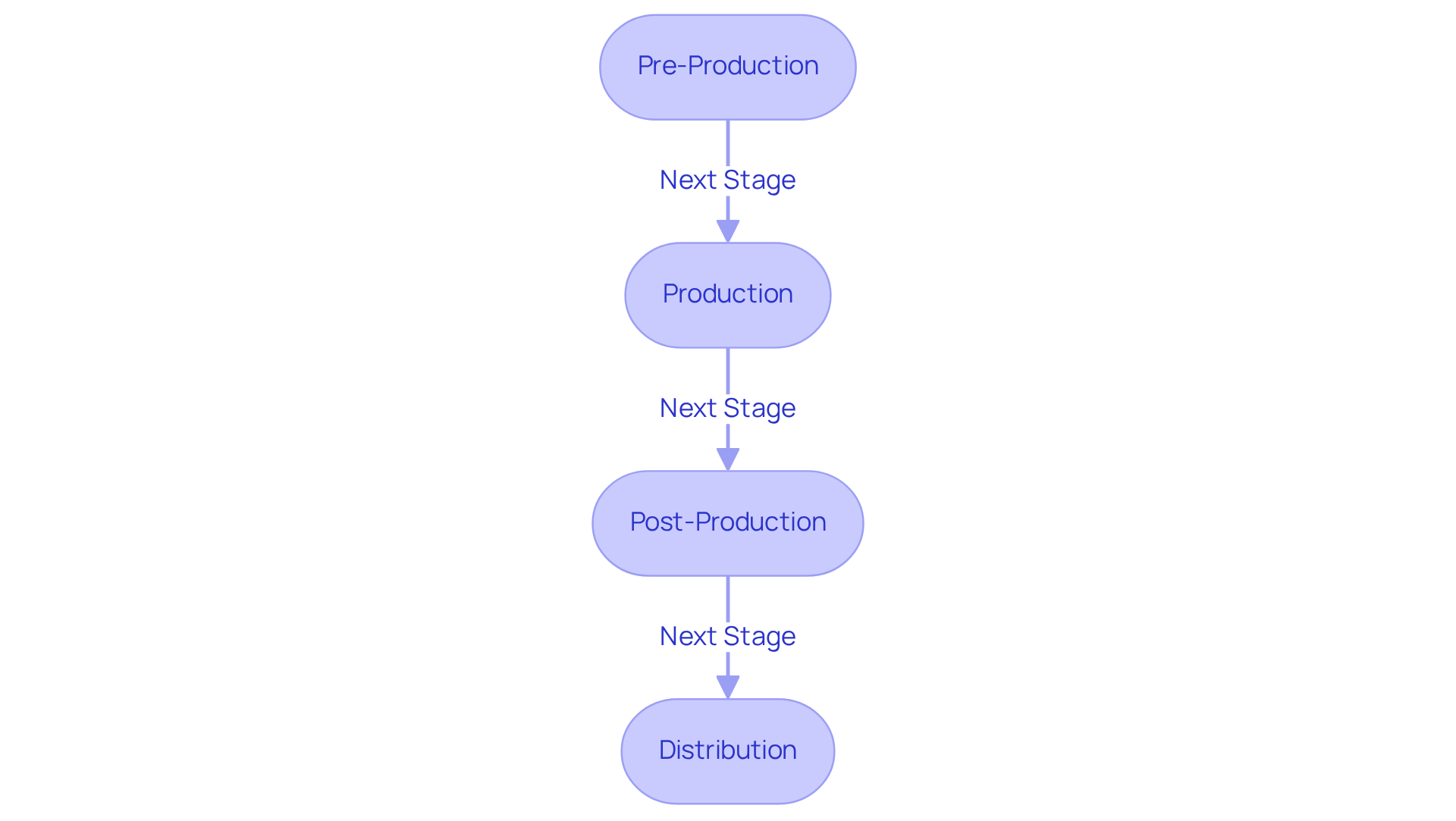
Introduction
Crafting compelling corporate videos has become an essential strategy for businesses aiming to boost their brand visibility and effectively engage their target audiences. In today’s competitive landscape, the demand for high-quality visual content is at an all-time high. This guide explores the multifaceted world of corporate video production, revealing how various video formats can serve distinct purposes - from marketing and training to storytelling and internal communications.
Yet, with so many options available, how can companies ensure their videos not only capture attention but also drive results? By understanding the unique strengths of each video format, businesses can tailor their content to meet specific goals and resonate with their audience. Furthermore, successful case studies demonstrate the impact of well-crafted videos on engagement and conversion rates.
As you navigate this dynamic field, consider how your organization can leverage corporate video production to enhance communication and foster deeper connections with your audience. The journey begins with a clear vision and a commitment to quality - are you ready to take the next step?
Define Corporate Video Production
Corporate videos production is all about crafting content tailored for companies and organizations, serving various purposes like marketing, training, internal communications, and storytelling. Unlike traditional advertisements, business films focus on delivering a company's message, values, and offerings in a compelling manner. These productions can take many forms, including marketing clips, product demonstrations, staff training sessions, and showcases of company culture, all aimed at boosting brand visibility and fostering engagement with target audiences.
The importance of corporate videos production is undeniable. In 2025, a staggering 93% of marketers reported that visual marketing yields solid and effective ROI, with 87% noting a direct increase in sales. Additionally, 90% of consumers believe that visual content enhances brand awareness, with such content capable of increasing brand awareness by 54%. This highlights the crucial role that high-quality visual content plays in shaping consumer behavior and engagement.
Successful corporate film campaigns illustrate this impact vividly. For instance, testimonial recordings leverage social proof by featuring real customers sharing their experiences, which significantly enhances credibility and trust. Moreover, businesses that utilize animated explanatory content often see greater ROI and stronger conversions across platforms like YouTube and LinkedIn.
Industry leaders emphasize the significance of corporate videos production for businesses. As Lucie Content pointed out, "The most impactful business films start with clear communication goals, regardless of the production methods used." This underscores the strategic foundation necessary for creating effective visual content. Furthermore, with 66% of advertisements now under 30 seconds, the shift towards shorter, engaging content aligns with evolving viewer preferences, making corporate productions not just a marketing tool but an essential element of modern business strategy.

Explore Different Types of Corporate Videos
Corporate videos production comes in various formats, each tailored to achieve specific goals and enhance communication within the company. Here are some key types:
-
Brand Clips: These recordings articulate a company's mission, vision, and values, playing a pivotal role in establishing brand identity. They resonate with audiences, fostering emotional connections that can lead to increased loyalty.
-
Product Demonstration Clips: Designed to showcase product functionality, these recordings inform potential customers and drive sales. Research indicates that product demonstrations can boost purchases by as much as 144%. Moreover, 90% of customers report that these demonstrations aid in their purchasing decisions, underscoring their effectiveness in influencing buying behavior.
-
Explainer Clips: These concise segments clarify complex ideas or services, often utilizing animations or graphics to enhance understanding. They are particularly effective in B2B contexts, where 91% of marketers assert that visual content significantly engages their brands. Additionally, 93% of marketers report a strong ROI from visual marketing, reinforcing the value of explainer content.
-
Training Clips: Crucial for onboarding and employee development, these materials ensure that staff are well-acquainted with company policies and procedures. They can markedly improve retention rates, as employees are more likely to remember information presented visually.
-
Testimonial Clips: Showcasing satisfied clients, these recordings build trust and credibility by highlighting authentic experiences with the company. Research shows that 93% of consumers are influenced by testimonials, making them a powerful tool for enhancing company reputation.
-
Event Recap Clips: Capturing highlights from corporate events, these recordings promote future gatherings and engage audiences. They serve as reminders of the organization's community involvement and can generate excitement for upcoming events.
-
Internal Communication Clips: Used to convey important updates or messages within the organization, these clips enhance internal engagement and foster a sense of community among employees. They can improve information retention and ensure that all team members are aligned with company objectives. With 85% of consumers expressing a desire for more visual content from brands, leveraging these formats can significantly boost engagement and conversion rates.
Integrating these diverse film types into a business strategy not only enhances communication but also aligns with current trends, such as the increasing demand for corporate videos production across various platforms.

Follow the Corporate Video Production Process
The corporate video production process is structured into several essential stages that collectively ensure the creation of impactful content:
-
Pre-Production: This stage is vital for success, involving the definition of the project's objectives, identification of the target group, scripting, storyboarding, and careful organization of logistics such as location and crew. Effective pre-production strategies can significantly enhance the efficiency and quality of corporate videos production. As industry specialist Deb Nicharot states, 'Thorough preparation prepares you for an efficient, intentional shoot,' ensuring that all team members align with the brand's vision and guidelines.
-
Production: Here, the actual filming occurs. This involves setting up equipment, directing talent, and capturing all necessary footage according to the script and storyboard. The execution during corporate videos production is crucial, as it translates the pre-production planning into compelling visual storytelling.
-
Post-Production: This stage focuses on editing the footage, incorporating graphics, sound design, and any necessary visual effects. A thorough post-production process in corporate videos production transforms raw footage into a cohesive and engaging final product, thereby meeting stakeholder expectations and enhancing the overall viewer experience.
-
Distribution: Once the recording is refined and finished, it must be effectively shared with the intended audience. This can involve uploading to social media platforms, embedding on websites, or distributing through email campaigns. Strategic distribution maximizes reach and engagement, ensuring that the content achieves its intended impact.
Understanding the average time spent on each phase is essential for effective project management. Typically, pre-production can take 4-8 weeks, depending on the project's complexity, while production and post-production phases also require careful scheduling to meet deadlines. By prioritizing pre-production, brands can significantly enhance their outcomes. In fact, 93% of B2B buyers believe that such content builds brand trust, and 91% of consumers feel more confident purchasing after viewing it. Therefore, investing time in pre-production is not just advantageous; it is crucial for producing content that connects with audiences and drives outcomes.

Set Clear Goals and Objectives for Your Video
To set clear goals and objectives for your corporate video, consider these essential steps:
-
Identify the Purpose: What do you want to achieve with the video? Is it to increase brand awareness, educate employees, or promote a new product? Defining this purpose is crucial.
-
Define Your Target Group: Who is your intended demographic? Tailoring your message to their needs and preferences is vital for engagement. Research shows that 93% of marketers believe visual content helps minimize friction during the buying process, while 91% of business owners feel such content influences their purchasing decisions. This makes audience alignment essential.
-
Set SMART Goals: Your goals should be Specific, Measurable, Achievable, Relevant, and Time-bound. For example, aim to boost website traffic by 20% within three months of the video’s release.
-
Establish Key Performance Indicators (KPIs): Identify metrics to measure your content's success, such as views, engagement rates, or conversion rates. Regularly tracking these KPIs enables informed adjustments to your strategy.
-
Review and Adjust: After the video is released, analyze its performance against your goals and modify future strategies accordingly. This review process is crucial for refining your approach and ensuring continuous improvement.
Successful corporate videos production campaigns often stem from well-defined objectives. As one marketing expert noted, 'Establishing clear objectives is the initial step in a successful marketing campaign for visual content.' Furthermore, during the COVID lockdown, 66% of companies utilized recordings to engage with key stakeholders, underscoring the importance of clear objectives in challenging times. By prioritizing audience understanding and measurable outcomes, brands can create impactful videos that resonate and drive results.

Conclusion
Mastering corporate video production is not just beneficial; it's essential for businesses that want to effectively communicate their message and engage their audience. Did you know that visual content can significantly boost engagement and conversions? By understanding the nuances of crafting tailored content, organizations can harness the power of visual storytelling to enhance brand visibility and foster meaningful connections.
Throughout this guide, we've explored key aspects of corporate video production. From defining the purpose and types of videos to outlining a structured production process, each element plays a vital role in creating impactful content. Setting clear goals and objectives is crucial, as these serve as the foundation for successful campaigns. With compelling statistics highlighting the effectiveness of visual content, it's evident that investing in high-quality corporate videos is a strategic necessity.
In an increasingly visual world, the call to action is clear: embrace corporate video production as a core component of your marketing strategy. By prioritizing well-defined goals, understanding your audience, and following a structured production process, brands can create compelling narratives that not only inform but also inspire. As the landscape continues to evolve, staying ahead in video production will enhance communication and solidify your brand's position in the market. Are you ready to take the next step?
Frequently Asked Questions
What is corporate video production?
Corporate video production involves creating content specifically designed for companies and organizations, serving purposes such as marketing, training, internal communications, and storytelling.
How does corporate video differ from traditional advertisements?
Unlike traditional advertisements, corporate videos focus on delivering a company's message, values, and offerings in a compelling manner, rather than just promoting a product or service.
What types of content can corporate videos include?
Corporate videos can take many forms, including marketing clips, product demonstrations, staff training sessions, and showcases of company culture.
What is the importance of corporate video production?
Corporate video production is crucial as it significantly boosts brand visibility and fosters engagement with target audiences. In 2025, 93% of marketers reported effective ROI from visual marketing, with 87% noting a direct increase in sales.
How does visual content impact brand awareness?
Visual content enhances brand awareness, with 90% of consumers believing it plays a vital role. Such content can increase brand awareness by 54%.
What examples illustrate the effectiveness of corporate video campaigns?
Testimonial recordings featuring real customers enhance credibility and trust, while animated explanatory content often leads to greater ROI and stronger conversions on platforms like YouTube and LinkedIn.
What do industry leaders say about corporate video production?
Industry leaders emphasize the importance of having clear communication goals for impactful business films, regardless of the production methods used.
How has the trend in advertisement length changed?
With 66% of advertisements now being under 30 seconds, there is a shift towards shorter, engaging content, making corporate productions essential in modern business strategy.





